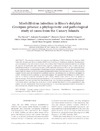Please use this identifier to cite or link to this item:
https://accedacris.ulpgc.es/jspui/handle/10553/45707
| Title: | Morbillivirus infection in Risso’s dolphin Grampus griseus: a phylogenetic and pathological study of cases from the Canary Islands | Authors: | Sierra Pulpillo, Eva María Fernández Rodríguez, Antonio Jesús Succa, Daniele Camara, Nakita Felipe Jiménez, Idaira Del Carmen Suarez Santana, Cristian Manuel Diaz Delgado, Josue Arbelo Hernández, Manuel Antonio Bernaldo De Quirós Miranda, Yara |
UNESCO Clasification: | 240111 Patología animal 240118 Mamíferos |
Keywords: | Central eastern Atlantic Ocean Cetaceans Morbillivirus Non-suppurative meningoencephalitis Risso’s dolphin |
Issue Date: | 2018 | Journal: | Diseases of Aquatic Organisms | Abstract: | The earliest evidence of cetacean morbillivirus (CeMV) infection dates from 1982, when the dolphin morbillivirus strain (DMV) was identified in bottlenose dolphins Tursiops truncatus stranded in the mid-Atlantic region. Since then, CeMV has been detected globally in at least 26 species of mysticetes and odontocetes, causing widespread mortality and a wide range of pathological effects. In the Canary Islands, DMV and pilot whale morbillivirus have been detected in cetacean species, including short-finned pilot whales Globicephala macro rhynchus and bottlenose dolphins. Risso's dolphins Grampus griseus have been reported year-round in waters of the Canary Islands and are considered a resident species. No information is currently available on CeMV prevalence in this species in this ocean region. We searched for evidence of CeMV infection in 12 Risso's dolphins stranded in the Canary Islands from 2003 to 2015 by means of histopathology, PCR and immunohistochemistry. PCR revealed 2 CeMV-positive animals (16.6%). Phylogenetic analysis showed that the strains from the 2 positive specimens were phylogenetically quite distant, proving that more than 1 strain infects the Risso's dolphin population in this region. We also determined that the strain detected in one of the specimens mainly circulated in the northeastern Atlantic Ocean from 2007 to 2013. | URI: | https://accedacris.ulpgc.es/handle/10553/45707 | ISSN: | 0177-5103 | DOI: | 10.3354/dao03248 | Source: | Diseases of Aquatic Organisms [ISSN 0177-5103], v. 129 (3), p. 165-174 |
| Appears in Collections: | Artículos |
SCOPUSTM
Citations
12
checked on Jun 8, 2025
WEB OF SCIENCETM
Citations
9
checked on Jun 8, 2025
Page view(s)
249
checked on May 17, 2025
Download(s)
120
checked on May 17, 2025
Google ScholarTM
Check
Altmetric
Share
Export metadata
Items in accedaCRIS are protected by copyright, with all rights reserved, unless otherwise indicated.
